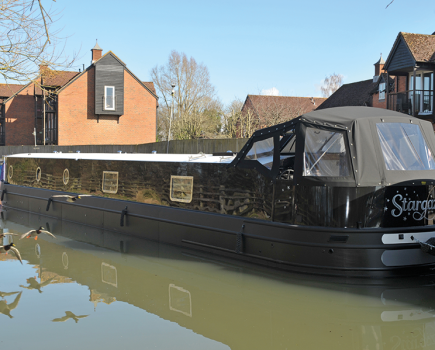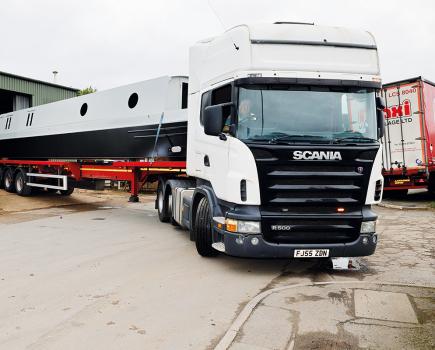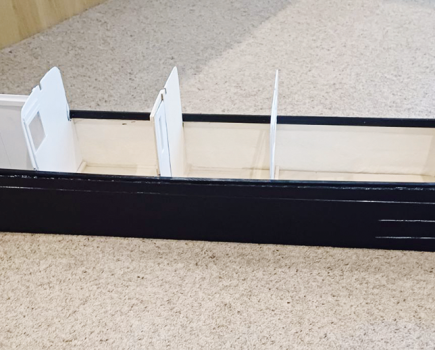Most people planning their new boat start with a blank sheet of paper in front of them. But Sarah Jury had a completely different approach: she bought an old boat and wanted to give it a new lease of life.

Most people planning their new boat start with a blank sheet of paper in front of them. But Sarah Jury had a completely different approach: she bought an old boat and wanted to give it a new lease of life.

“When I saw the advert for Henry H, the boat just sang to me,” she says. “It was very distinctive, very different and very charming.” Within a week she’d bought it. Henry H had a lot going for it – not least a lovely Gardner engine. But it had been a self fit-out that had never been finished, so the inside was in a rather sad state. The plan was to refit the boat to the highest standard. “In a way, I was glad the boat was part fitted out, because it showed how the space could work,” adds Sarah. “Had it been just a shell, I might not have seen the potential.”

Sarah and her husband, Andy, chose Wharf House Narrowboats in Braunston to refit Henry H – appropriate because the boat has a very Braunston-centric history. “We took the inside back to nothing,” says Phill Abbott, who owns Wharf House. “Even the insulation and the batons are new, and so is the wiring and electrics; so it was like fitting out a new shell.”

The result shows that you don’t have to start from scratch to get a sparkling new boat; it also demonstrates that a short boat – it’s just a touch over 40ft – really can work.


Design and Layout

As we said in the intro, the first owner of Henry H had produced a layout that worked – in fact, the design peculiarities of the boat mean it’s pretty much the only option. There’s a semi-trad rear deck, with the engine room immediately forward. Next comes a small walk-through bathroom, followed by a saloon, the galley and, finally, the cabin at the bow.
“When we bought the boat, it had Tudor-style beams in the saloon and a hip bath in the bathroom,” recalls Sarah. She decided that as the space was so restricted, she’d go for a very high spec. “There’s not much space to fill, so we could choose more expensive fittings and finishes because we didn’t need much of anything,” says Sarah “But I admit, I splurged and spent a lot on it!”
Inside, the boat is crisp, clean and contemporary, with white walls. Underneath the paint there’s a mix of birch ply and tongue and groove. The trim, which is also painted, is American Tulip Poplar, known as Canary Wood – a material used a lot in the furniture industry because it’s easy to work with and gives a good clean finish. The white is offset by oak highlights, while the floor is hard-wearing Karndean.
Exterior
Although the main story of the boat is the interior refit, it’s worth spending time looking at the outside because it has such a strong influence on the decisions made inside. It’s a boat with a very traditional look. “I tell people it’s a working boat that has shrunk in the wash,” says Sarah. So the gunwales are low, as is the ‘back cabin’ that makes up the rear half of the boat. The forward half is under cloths with traditional strings – although there’s a cabin underneath rather than a hold. There are also portholes, which are exposed by rolling up the cloths; they have black powder-coated frames to help blend in. The portholes in the back cabin part of the boat have been changed from small Grand Union style ones, to slightly larger tug-style brass.
There’s no well deck; this boat, in effect, has an extended cabin. For a boat as short as this it’s a good use of space, and it looks good, too. In fact, if you want a boat with an extended cabin, it’s worth considering this approach. The foredeck has a hatch that used to open into the bedroom. “No-one could quite understand why you’d want a hatch like that,” says Phill Abbot, “so we’ve welded it shut.”
Perhaps unexpectedly, this boat is a semi-trad. A new locker has been fabricated on the rear deck to house the mooring pins and so on, and to provide somewhere to stand your tea. The rear hatch arrangement is slightly strange; instead of a slide there’s a lift-up lid that looks rather inelegant when it’s open because it won’t lie flat on the roof. There are two sets of side doors, in the engine room and the saloon; the latter pair also have roof hatches, making the openings big enough to use as access if required. Other exterior features include a pigeon box over the engine room.
Overall, with the look of a much older boat and a real sense of style, it’s eye-catching
Engine Room
Moving inside, you’re immediately confronted by the impressive Gardner engine. It stayed where it was during the refit, although everything around it has been replaced. There’s white painted tongue and groove on the walls, and traditional chequer plate on the floor. Care has been taken to make sure everything is as accessible as possible for maintenance. The electrical cupboard is on the forward bulkhead and does a good job of hiding modern-looking things like the inverter.
Shower Room
The white theme continues in the shower room, but here the walls are lined with glossy shower board rather than paint. It gives the whole room a touch of glamour – a feeling that is emphasised by the under-gunwale LED lighting. There will be more bling when chromed porthole liners have been installed (they hadn’t arrived by the time we looked over the boat).
One whole side of the room is taken up with a huge shower cubicle. It’s a full metre long by 600mm wide and was a key demand of Andy, who wanted to make sure he had room to move while in the shower. It’s been fitted with an impressive shower head, while the pump is an Intelligent Control Whale Gulper that requires no switch; it simply senses water and starts automatically.
The compromise for the huge shower is a tiny wash basin. It might be small, but it’s still stylish. Above it, there’s a mirrored cabinet to provide some storage.
The toilet is a Thetford cassette with a ceramic bowl. The hatch that gives access to the cassette is in the saloon.
Saloon
A lovely oak door leads from the shower room to the saloon, and the feeling of quality is enhanced by the brushed door handles.
Although the room is just eight feet long, it still feels spacious thanks to the white colour scheme and perfectly to scale furniture. It also helps that, from the shower room door there’s a view right through the saloon, the galley, and the cabin. There are two built-in cupboards, one with shelves above, while the other has room for a flat-screen TV on top. The opposite corner houses a Lockgate Refleks diesel stove; it’s the boat’s only source of heating but should be more than adequate. It stands on a stainless steel hearth and has a glamorous black glass surround.
The armchairs are small enough to not take up too much room, but are comfortable enough to relax in after a day’s locking. They also have a style that suits the boat.
There are plenty of dimmable LED lights in the ceiling, and more under the gunwales.
Galley
The galley is small but with a surprising amount of storage. The units have been specially made and include a range of cupboards, drawers and even a pull-out can cupboard. The doors are painted white to match the rest of the boat and are teamed with beautiful oiled oak worktops. On one side there’s a stainless steel Franke sink with a very smart tap. Because the boat is so low in the water, a normal sink waste would have been too near the water, so there’s another Whale Gulper pump with an automatic start instead. On the other side there’s a Wallas diesel-fired two-burner hob, salvaged from the original fit-out. “When we took it out,” says Phill, “we realised that not only had it not been used, it hadn’t even been connected to a diesel supply!” The unit underneath has been specially built to make sure there’s adequate ventilation. Another unit contains an integrated fridge, hidden behind a door.
The galley is in the part of the boat that’s under the cloths, so the cabin sides slope inwards and the portholes are likely to be covered over. You’d think this would make the space feel small and cramped, but it doesn’t. That’s partly due to all the white paint, but it’s also because of very generous headroom, and two skylights in what would have been the top plank. “We wanted to make sure as much light as possible was let in,” says Phill, “so we’ve lowered that part of the ceiling slightly so the openings could be wider at the bottom.”
Cabin
There’s not much to the cabin, frankly, apart from the bed, which takes up the whole space. “It’s a much bigger bed than we had on our longer boat!” says Sarah. The mattress, which is in two halves, had been specially made to fit the tapering shape of the boat, and as it had hardly been used (and would have been expensive to replace) it’s been kept. There are two more skylights, and a couple of reading lights.
Storage is rather limited. There are no wardrobes, which some people might find a problem. There is, however, a large cupboard under the bed. “We’ll have to be rather disciplined and only have on board what we really need,” admits Sarah.
As this is likely to be mainly a weekend boat, with just a few longer trips thrown in, it’s a challenge that should be reasonably easy to cope with. The forward end of the space is taken up by the water tank.
Technical
As with many Gardners, Henry H’s 2LW engine has a rather glamorous sounding past. It came from South Africa where it powered a train in a diamond mine. It’s installed offset to one side, so there’s an hydraulic drive system to turn the prop.
It’s run for only a handful of hours since installation and has needed relatively little attention; vintage engine expert Tony Redshaw’s son, Paul, has given it the once over, though (see our feature on Tony Redshaw CB, April 2011). Extra diesel systems, run from a separate tank, supply the stove and hob.
Electrical power comes from four 142Ah domestic batteries and there’s also a starter battery. A Victron battery monitor shows the state of charge and there’s a 1.6kW Victron inverter/charger.
The electrical cupboard also contains a galvanic isolator and a clever box that runs the dimmer switches throughout the boat. The lights themselves are by Cantalupi, a high-end Italian designer brand.
On the Water
This boat might be short, but it’s also relatively deep draughted. This means the steering is a little heavy, although perhaps that’s exactly what you’d expect on a boat modelled on traditional working boats. But the length (or lack of it) means you can turn in places where longer boats can’t, and you can slot into mooring spaces that other boats have to pass by.
The Gardner has traditional controls, with a grab handle to select forward or reverse, and a speed wheel to control the revs. This is a semi-trad, though, so the controls aren’t as close to hand as they would normally be. What is clear is that the engine provides plenty of power: even on tickover, the boat is eager to get moving.
Conclusion
This is one of those boats you can’t help but like – it’s charming with bags of character and style, and it shows that it’s possible to go small and still have everything you need. It also demonstrates that it’s possible to take a boat in a sorry state and bring it back to life.
As you might have guessed by now, the cost of this refit is quite high: Sarah says she’s spent around £60,000 on Henry H. She could have brought the project in for a lot less, but she wanted to do things the best she could. Many of the fittings are high end and it shows. The Wharf House fit-out is also top quality – especially as the interior shape of the boat is peculiar, even by narrowboat standards!
The final figure will be higher because the boat will be repainted and have new cloths and strings within a year. The name and the fictional Borley, Hussey & Glossop Ltd will remain, even though they were connected with the previous owner. “I hope he would approve of what we’ve done,” says Sarah.
Reviving this boat has clearly become a labour of love and it shows that if you’re considering a new boat – especially if you want something a little bit different – remember that a canvas for your ideas might already be out there.
Image(s) provided by:
Archant







